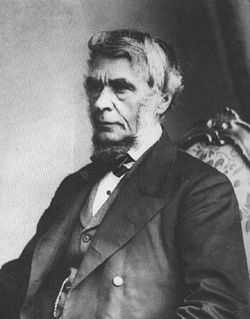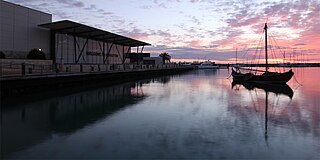Pterostylis angusta, commonly known as the narrow shell orchid, is a species of orchid endemic to the south-west of Western Australia. As with similar greenhoods, the flowering plants differ from those which are not flowering. The non-flowering plants have a rosette of leaves flat on the ground but the flowering plants have a single flower with leaves on the flowering spike. In this species the flower is green, white and brown with an inflated base, a narrow hood and the longest labellum of any Western Australian Pterostylis species.

Pterostylis daintreana, commonly known as Daintree's greenhood, is a species of orchid endemic to eastern Australia. The non-flowering plants have a rosette of leaves on short stalks but flowering plants have up to ten flowers with rosettes on the side of the flowering spike. The flowers are translucent white with dark green lines and long, downcurved lateral sepals.
Pterostylis dilatata, commonly known as the robust snail orchid, is a species of orchid which is endemic to the south-west of Western Australia. Non-flowering plants have a rosette of leaves but flowering plants lack a rosette and have a single green and white flower on a flowering stem with stem leaves. The flowers appear in winter and have lateral sepals which almost close off the front of the flower.
Pterostylis insectifera, commonly known as the insect-lipped rufous greenhood, or leaden rustyhood is a plant in the orchid family Orchidaceae and is endemic to the south-west of Western Australia. Both flowering and non-flowering plants have a relatively large rosette of leaves. Flowering plants have a similar rosette and up to eight or more flowers which have long, stiffly-held lateral sepals and a protruding, insect-like labellum.
Pterostylis macrocalymma, commonly known as the large-hooded rufous greenhood or Murchison rustyhood is a plant in the orchid family Orchidaceae and is endemic to the south-west of Western Australia. Both flowering and non-flowering plants have a relatively large rosette of leaves. Flowering plants also have up to ten or more white flowers with bold green or pale brown lines and a broad spoon-shaped, insect-like labellum.
Pterostylis macrosceles, commonly known as the slender rufous greenhood is a plant in the orchid family Orchidaceae and is endemic to the south-west of Western Australia. Both flowering and non-flowering plants have a relatively large rosette of leaves. Flowering plants also have between four and eight white flowers with green brown lines and small, insect-like labellum. It is distinguished from other Western Australian greenhoods by the unusually long thread-like tips on its sepals.
Pterostylis platypetala, commonly known as the broad-petalled snail orchid, is a species of orchid endemic to the south-west of Western Australia. It has a rosette of leaves and when flowering, a single green and white flower with relatively wide petals. In ideal conditions it can form colonies of hundreds of plants and often grows under melaleucas on the edge of winter-wet areas.
Pterostylis roensis, commonly known as the painted rufous greenhood or dark rustyhood is a plant in the orchid family Orchidaceae and is endemic to the south-west of Western Australia. Both flowering and non-flowering plants have a relatively large rosette of leaves. Flowering plants also have up to six green or brown to blackish flowers with translucent white panels and a dark brown, fleshy, insect-like labellum.
Pterostylis rogersii, commonly known as the curled-tongue shell orchid, is a species of orchid endemic to the south-west of Western Australia. As with similar orchids, the flowering plants differ from those which are not flowering. The non-flowering plants have a rosette of leaves but the flowering plants lack a rosette and have a single flower with leaves on the flowering spike. This greenhood usually has a white and reddish-brown striped flower with a long, curved labellum and is found along the south coast between Binningup and Esperance.

Pterostylis sargentii commonly known as the frog greenhood, is a plant in the orchid family Orchidaceae and is endemic to the south-west of Western Australia. It is a relatively common orchid which has up to six relatively small, white flowers with green or brown stripes and a fleshy, three-part, frog-like labellum. Non-flowering plants have a rosette of leaves on a short stalk.
Pterostylis spathulata, commonly known as the spoon-lipped rufous greenhood or Moora rustyhood is a plant in the orchid family Orchidaceae and is endemic to the south-west of Western Australia. Both flowering and non-flowering plants have a relatively large rosette of leaves. Flowering plants also have up to ten or more white and green or brown flowers with fine, upturned tips on the lateral sepals and a spoon-shaped, insect-like labellum.
Pterostylis brevichila, commonly known as the dwarf shell orchid, is a species of orchid endemic to the south-west of Western Australia. As with similar greenhoods, the flowering plants differ from those which are not flowering. The non-flowering plants have a rosette of leaves flat on the ground but the flowering plants have a single flower with leaves on the flowering spike. In this species, the flower is small and white with brown stripes and is similar to P. aspera but smaller in stature.
Pterostylis brunneola, commonly known as the giant snail orchid, is a species of orchid endemic to the south-west of Western Australia. Both flowering and non-flowering plants have a large rosette of leaves flat on the ground and flowering plants have a single distinctive white flower with pale fawn stripes and have leaves on the flowering spike. This species often forms large colonies, sometimes with Caladenia species.

Pterostylis echinulata, commonly known as the hairy-leafed snail orchid, is a species of orchid endemic to the south-west of Western Australia. Both flowering and non-flowering plants have a compact rosette of leaves flat on the ground and flowering plants have a single pale yellowish-green flower.
Pterostylis erubescens, commonly known as the red sepaled snail orchid, is a species of orchid endemic to the south-west of Western Australia. Non-flowering plants have a rosette of leaves flat on the ground but flowering plants lack a rosette and have a single large green flower which turns reddish-brown as it ages, and has leaves on the flowering spike.
Pterostylis glebosa, commonly known as the clubbed snail orchid, is a species of orchid endemic to the south-west of Western Australia. Non-flowering plants have a rosette of leaves flat on the ground but flowering plants usually lack a rosette and have a single green and white flower with club-like lateral sepals. It sometimes forms colonies of thousands of plants.

Pterostylis karri, commonly known as the karri snail orchid, is a species of orchid endemic to the south-west of Western Australia. Both flowering and non-flowering plants usually have a small rosette of leaves and flowering plants have a single green and white flower with unusually long, erect lateral sepals. Like some similar greenhoods, it often forms dense colonies.
Pterostylis lortensis, commonly known as the Lort River snail orchid, is a species of orchid endemic to the south-west of Western Australia. Non-flowering plants have a rosette of leaves flat on the ground but flowering plants usually lack a rosette and have a flowering stem with leaves and a single pale green and white flower with narrow, club-like lateral sepals.
Pterostylis microglossa, commonly known as the Kalbarri shell orchid, is a species of orchid endemic to the south-west of Western Australia. Non-flowering plants have a rosette of leaves flat on the ground but flowering plants lack a rosette and have a flowering stem with leaves and a single green, white and brownish-red flower.
Pterostylis atrosanguinea, commonly known as the crowded banded greenhood, is a plant in the orchid family Orchidaceae and is endemic to the south-west of Western Australia. The plants either have a rosette of leaves in the years when not flowering or stem leaves on a flowering spike. When flowering, it has up to twenty flowers that are dark reddish to blackish brown with translucent white areas. The labellum is dark reddish black and covered with short, stiff hairs.















